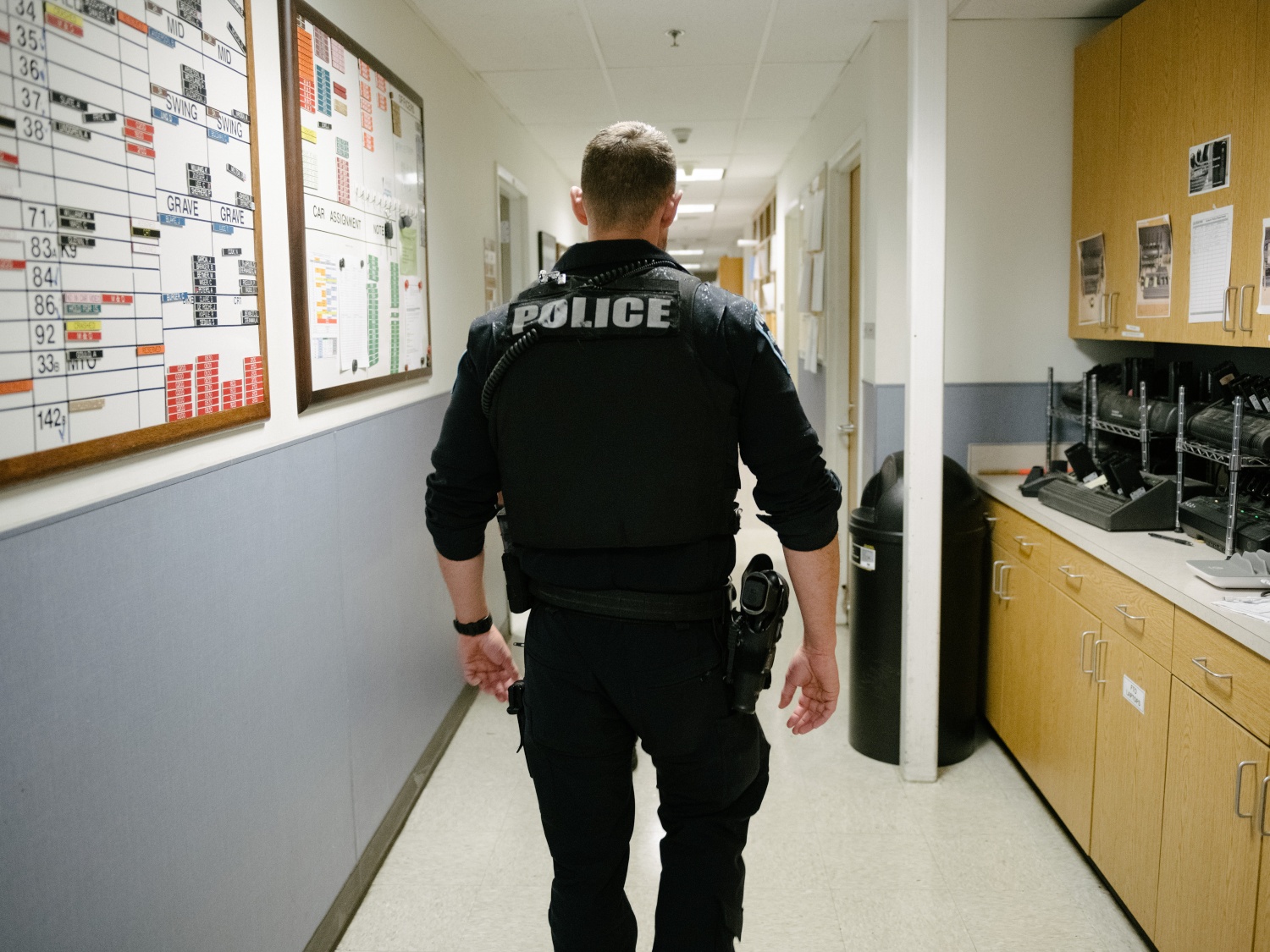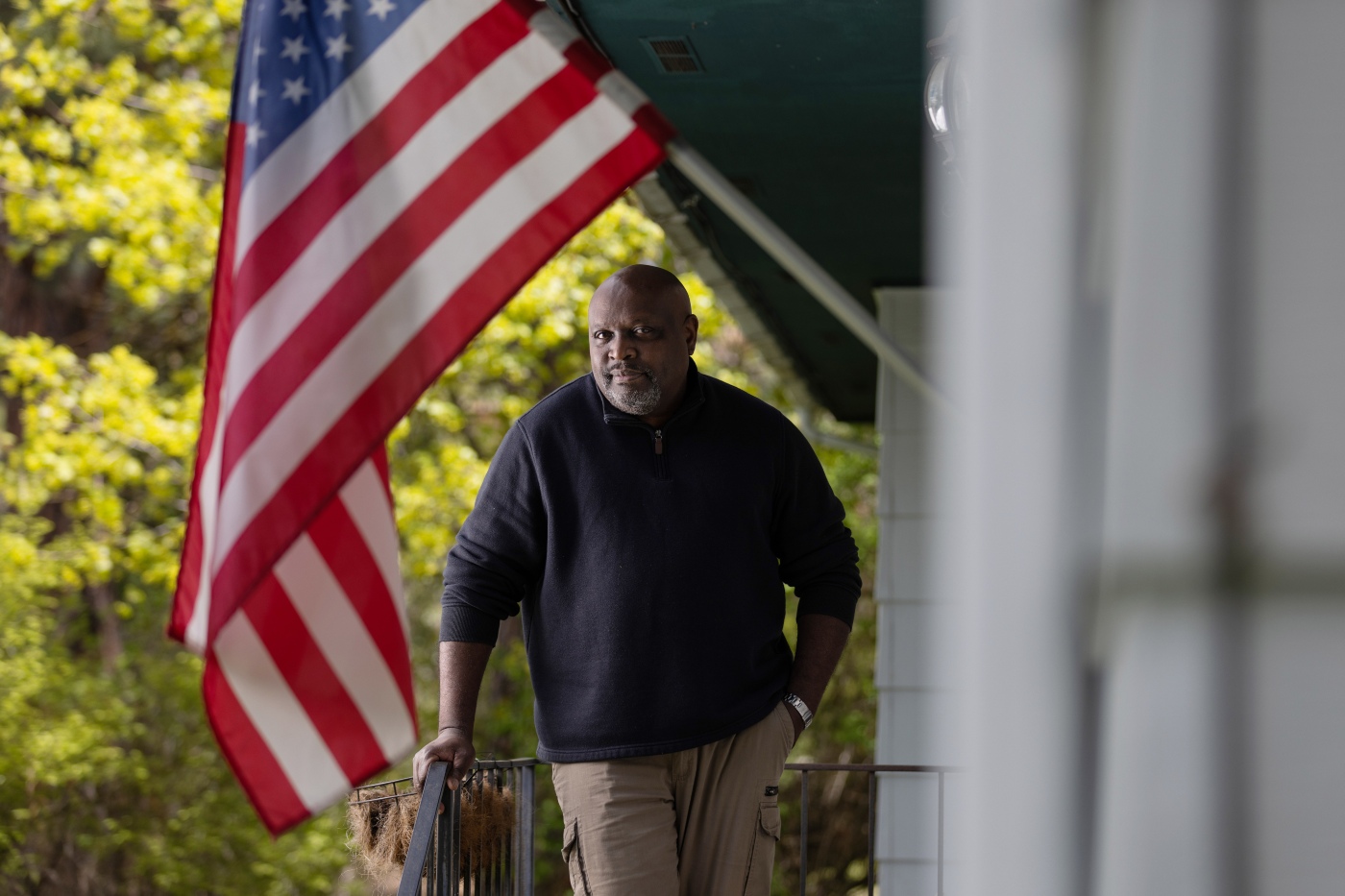Justice reform advocates have been disappointed by choices to spend flexible federal recovery funds on items such as tasers and new police cruisers.
By Brandon Block / Crosscut.com / May 16, 2022
Federal Way Police Chief Andy Hwang went before city council last October and presented a disturbing picture of lawlessness in the city. Gun violence. A drug epidemic. Rampant car theft.
“People are visibly seeing more people that are on drugs. They’re visible, and it’s making people nervous,” Hwang told the council. “I can tell you, I’ve been in this business for a long time. This is not going to go away anytime soon.”
As Hwang’s presentation showed, long-term statistics do not support this picture. Both property crimes and crimes against persons have actually gone down significantly in Federal Way since 2016 (although there was a 4% increase last year).
Nevertheless, the situation felt dire, Hwang said: Police accountability laws passed by the state Legislature have tied officers’ hands and emboldened “criminal offenders.”
Hwang proposed hiring 13 new officers and buying 25 new patrol cars, at a cost of $5.3 million over the next three years. The city finance director told the council that Federal Way could help pay for this plan by tapping $2.1 million from the city’s allotment of American Rescue Plan Act, or ARPA, dollars, which cities began receiving from the federal government last year.
“Having higher visibility police officers will make our residents feel safer,” Hwang said. “We have to do this, or we’re going to have a big problem as a community.”
Hwang stands among many law enforcement leaders pitching investments in policing as the best response to rising national anxiety over crime. Just two years after the murder of George Floyd sparked a reckoning over the role of police and how communities fund public safety, local officials throughout Washington state are instead putting millions in flexible, one-time federal recovery dollars back into police budgets.
Federal Way City Councilmember Lydia Assefa-Dawson countered that putting more money into policing did not necessarily address the root causes of crime. Why not put those recovery dollars into community programs targeting addiction or homelessness?
“I’m talking about not criminalizing what they’re doing,” she said, “but having people in our community who could actually go to them, meet them where they’re at, definitely provide them with resources and help them get out of that situation.”
The city council still approved the police spending unanimously, earmarking $2.1 million in ARPA funds for new cars and an ongoing yearly $1.4 million commitment from the city’s general fund to hire 13 new officers.

Left: The Auburn Police Department’s new Axon body cameras charge in the department’s briefing room. Right: Officer Brian Cox of the Auburn Police Department displays a new taser. Both the cameras and tasers were purchased in part with federal recovery funds from the American Rescue Plan Act. (Grant Hindsley for Crosscut)
A reversal on ‘defund’
Cities from Spokane to Yakima are buying their officers new cruisers. Tacoma and Lynnwood purchased officer-worn body cameras. Pierce County used $4 million in ARPA funds to give every sheriff’s deputy a $10,000 bonus, a practice becoming so common that even Seattle is now preparing to follow suit. Walla Walla is paying officer salaries out of their federal pot. And in Auburn, the city used rescue plan money to purchase 123 new tasers.
The murder of Floyd by Minneapolis police in May 2020 and the resulting Black Lives Matter demonstrations around the country forced a reconsideration of how communities invest in public safety. Advocates called for “defunding” police and spending toward community programs such as restorative justice courts or behavioral health outreach.
But now, flush with federal stimulus money, some local governments are doing the opposite — using federal dollars to again invest in cops and incarceration.
“My feelings on it are frustration,” said Jim Leighty, a police accountability activist in Spokane. “They want to put money into police cars, yet if I see somebody on the street having a severe mental health crisis, I have no one to call.”
Although crime has consistently decreased since the 1990s, the United States has seen a spike in murders since the pandemic began. In response, Democratic leaders in cities like New York, Seattle and the District of Columbia have backed away or reversed course on efforts to reduce police funding, with many increasing police budgets in 2021. President Joe Biden has spoken approvingly of cities spending ARPA funds on police, distancing himself from the “defund” movement.
“The answer is not to defund the police,” Biden said at a press conference with law enforcement leaders last Friday. “The answer is to fund the police with the resources and training they need to protect our communities.”
This story is a part of Crosscut’s WA Recovery Watch, an investigative project tracking federal dollars in Washington state.
Some local governments in Washington state have already spent much of their ARPA dollars, while others are expected to make spending decisions throughout the coming months. Officials have until the end of 2024 to obligate the funds and until 2026 to spend them.
Federal rules denote four broad categories of eligible uses of ARPA money: responding to the public health or economic impacts of the pandemic; premium pay for essential workers; water, sewer or broadband infrastructure; and replacing lost revenue.
Cities have in some cases stretched the meaning of those categories further. Auburn, for example, filed its taser and camera purchase under the category of “mitigating the negative economic impacts of COVID-19.”
Police department purchases are often filed under “lost revenue,” because it can encompass nearly any government service.
Nationally, cities and states have also tested the limits of the federal government’s definitions.
Lawmakers in Alabama earmarked $400 million of its federal money to build a new prison. The Department of Treasury’s final rule, released in January, contained vague language suggesting that building a new prison may not satisfy the criteria of being “related and reasonably proportional to a harm caused or exacerbated by the pandemic.”
Alabama hasn’t blinked. The state signed a contract in late April with a construction company, and Gov. Kay Ivey has argued that Treasury’s rule doesn’t disqualify the project. So far there’s little indication the federal government would step in to block states from making their own decisions about how to spend the money.
The Washington Association of Sheriffs and Police Chiefs, which advocates on behalf of law enforcement agencies statewide, told Crosscut that spending recovery money on police equipment remains a local decision and deferred comment to local police departments.
Community pressure on public safety
Local leaders say they are using federal resources for a variety of community needs, not just police. Some feel caught in the headwinds of a national panic over crime and feel pressured to expand policing as a response. Others say they’re going to have to replace cop cars eventually anyway, so they might as well use federal funds for it while they can.
Spokane City Council President Breean Beggs, a civil rights attorney who has long championed criminal justice reform, characterized the council’s allocation of $2.4 million for 35 new police cars as an outlier — the majority of the city’s ARPA allocations so far have been for “human-centered priorities,” like affordable housing and mental health.
“As a city council member, my job is to look over the whole table [and] make compromises,” Beggs said. “I think at the end of the day, when you look at how Spokane spent their money, I think most people who have a progressive bent will be pretty happy.”
Beggs said he pushed back on an even larger request for new police cars sought by the mayor’s office, which he said has been eager to give the police whatever they ask for.
The city bought two Tesla patrol cars last year in an attempt to nudge the department toward electrification, but officers rejected them as too small and confined for police needs. The department ultimately purchased eight electric and 27 gas-powered vehicles. According to the Spokesman-Review, two Spokane council members wanted to buy twice as many cars, but their amendment was voted down.
Beggs said it’s politically difficult to turn down police funding requests because some constituents see more officers or equipment as the only tangible way to “do something” about crime. And those decisions quickly get politicized by police departments.
“The police leadership are always trying to get more resources,” Beggs added. “The thing that I find disheartening is that they equate whether or not you buy them new vehicles fast enough [with] whether you support them or not.”
Assefa-Dawson, the Federal Way City Council member, said in an interview with Crosscut that the city is under pressure from constituents to hire more police. The narrative around increased crime, she said, makes it tricky to even question requests for more police funding.
“When you have a segment of the population, or people who I hear say, ‘We’re not safe, and the only way we can feel safe is to have more police,’ it’s hard to fight that,” she said.
Assefa-Dawson explained that she voted for the new cars and officers because she trusts the police department’s judgment on what’s a need versus a want. She would also like to see more discussion of violence interruption programs that work with youth outside the criminal justice system to get at the root causes of violence. But she feels those programs aren’t taken seriously by the city and don’t have the same leverage as the police chief.
“Do I want police presence?” she asked. “I sure do. But [are] police the only answer to some of the issues that we’re dealing with? No. And I think that’s a conversation we have to have.”
Transparency on spending
Cities also vary greatly in how transparent they are about their ARPA spending choices and how openly they invite input from residents. The city of Spokane hired a new employee to do outreach in communities of color and held multiple “town halls” last October to solicit input from residents, according to Beggs.
By contrast, other cities have allocated much of their rescue plan funds without holding prominent public meetings on the topic, embracing police narratives about public safety needs and approving significant spending with little to no debate.
The city of Auburn spent more than $2 million of its $14.7 million in ARPA money on law enforcement and jail expenses.
Mayor Nancy Backus said that includes $650,000 for officer raises negotiated in a recent collective bargaining agreement, $200,000 for police hiring incentives and $800,000 to make up for revenue shortfalls at the South Correctional Entity, a regional jail.
In a meeting on Oct. 18, the Auburn City Council voted unanimously to purchase a bundle of new equipment for officers, including tasers, body cameras and dash cameras, tapping $586,000 in ARPA funds to pay the first installment on the purchase. The bundle also included virtual reality headsets for training simulations.
Receipts included in the council agenda list dozens of items in the “Officer Safety Plan 7 Plus Premium” bundle totaling $1.7 million. There was no discussion of the expenditure in the 28-minute meeting. Backus said in an interview that the decision was discussed in a separate council work session.
Backus said the majority of the funds went toward officer-worn body cameras, but she was unable to break out the costs because the purchase was made as a bundle. Although the department already had them, Backus defended the inclusion of new tasers in the purchase.
“Public safety and the safety of community is one of the most important things that we do,” Backus said. “And so, yes, I do think it’s appropriate that a portion of the ARPA funds for allowable purposes have been utilized for body cameras, dash cameras, and tasers.”
Auburn Police Cmdr. Cristian Adams pushed back on the idea that recovery money spent on replacement tasers could be better used elsewhere.
“We could have a new library,” he said, “but if we don’t have officers properly equipped to deal with any vandalism or burglaries or any other things that could happen at that library, then that library could be destroyed and become just another place where people are scared to go due to high crime rates.”
Replacing patrol fleets
In Yakima, the city council voted to spend $4.6 million to buy 57 police cars — replacing nearly the entire fleet, according to a staff report submitted by the city manager. This one purchase represents 17% of the $26.2 million the city got from the American Rescue Plan.
Yakima City Manager Bob Harrison said the city’s police cars have needed replacing since 2019, and without the federal money the city would have taken it from elsewhere or borrowed money, which is how it purchased its current fleet in 2013.
“We didn’t have that revenue in the budget, so we either would have had to raise taxes, or we would have had to cut the budget somewhere else in order to replace those kinds of costs going forward,” Harrison said.
Find tools and resources in Crosscut’s Follow the Funds guide to track down federal recovery spending in your community.
Yakima Police Lt. Ira Cavin said the department switched from a shared fleet of about 35 cars to a “take home” system of about 74 cars in 2013. Although the upfront cost is high, he said the city saves money in the long run because the cars don’t need to be replaced as often.
Cavin noted the department has struggled to recruit new officers and currently has 22 vacant positions. He recognized that the city has numerous priorities to balance, but said using ARPA funds for equipment purchases like police cars can help free up space in the general fund for those other needs.
“You’ve got to look at how you can take that and really divide that money out so that it can really do the best benefit across the entire city,” Cavin said.
While shopping for cars, the police department came across a company called Flock, which sells cameras that automatically scan license plates, Cavin said. The city ended up setting aside $125,000 in ARPA funds to pay for the cameras, which Cavin says have helped track stolen vehicles.
Harrison emphasized that the city is also spending money on social services, citing a $2 million investment in a domestic violence shelter and $1.5 million in homelessness and mental health programs outlined in a memo to city council last September.
Other needs crowded out
Council members and advocates describe a dynamic where police departments are often in a better position to advocate for resources than community groups or even other city agencies. They say leaders are often quick to respond when law enforcement asks for more money, but skeptical of needs for community services they see as more pressing.
Terri Anderson, statewide policy director of the Tenants Union of Washington State, said she wrote numerous letters to the Spokane County Commission in 2020 making the case for them to allocate Coronavirus Aid, Relief and Employment Security, or CARES, Act dollars to rent relief for tenants facing eviction, but got no reply from commissioners.
Around that same time, the Spokane County Commission approved $50,000 to study the feasibility of building temporary tent jails to address overcrowding, and explored using federal COVID-19 relief money to fund a $32 million jail project proposed by law enforcement leaders. The conversation around jail expansion has been ongoing for years in Spokane.
“And so it was frustrating on both [sides],” Anderson said. “The county commissioners actually said they were considering a tent jail because that was their preference over releasing people for their health … at the very same time [as] not giving rental assistance.”
Curtis Hampton, an activist involved with numerous Spokane justice reform organizations, said he sees investments in law enforcement as coming from a place of fear. City and county leaders continue talking about more cops and bigger jails, he said, because they have failed to take action on justice reforms that would lower jail populations.
“If locking people up made us safer,” Hampton said, “America would be the safest country on Earth.”
Hampton said he is starting up a court watch program to help monitor recent cases he saw with defendants who had clear unmet mental health and housing needs.
“I want our society to start thinking of root cause … all the people that are in our jails that have some type of mental health or drug addiction. That tells you a lot,” he said. “It tells you automatically that you need to go back to your communities and start helping.”
As of March, more than 70% of local ARPA funds in Washington cities remained unallocated, according to an analysis by the Southern Economic Advancement Project, which looked at a sample of 40 Washington cities with populations between 20,000 and 250,000.
Advocates believe they still have limited time to press for more substantive investments that address community needs outside of the criminal justice system.
Leighty, the Spokane police accountability activist, offered a few ideas, including mental health resources and a nonpolice crisis response line. He also said he’d like to see the money put into resources to help people experiencing homelessness — public bathrooms and drinking fountains are two things that would make their lives much more tolerable.
“If we would provide things, resources, like just a drinking fountain to save lives,” he said, “we’re talking about human beings here, and instead of doing things for basic necessities, we’re buying more police cars.”
FEATURED IMAGE: Officer Brian Cox in the Auburn Police Department on Thursday, May 12, 2022. (Grant Hindsley for Crosscut)
Visit crosscut.com/donate to support nonprofit, freely distributed, local journalism.





